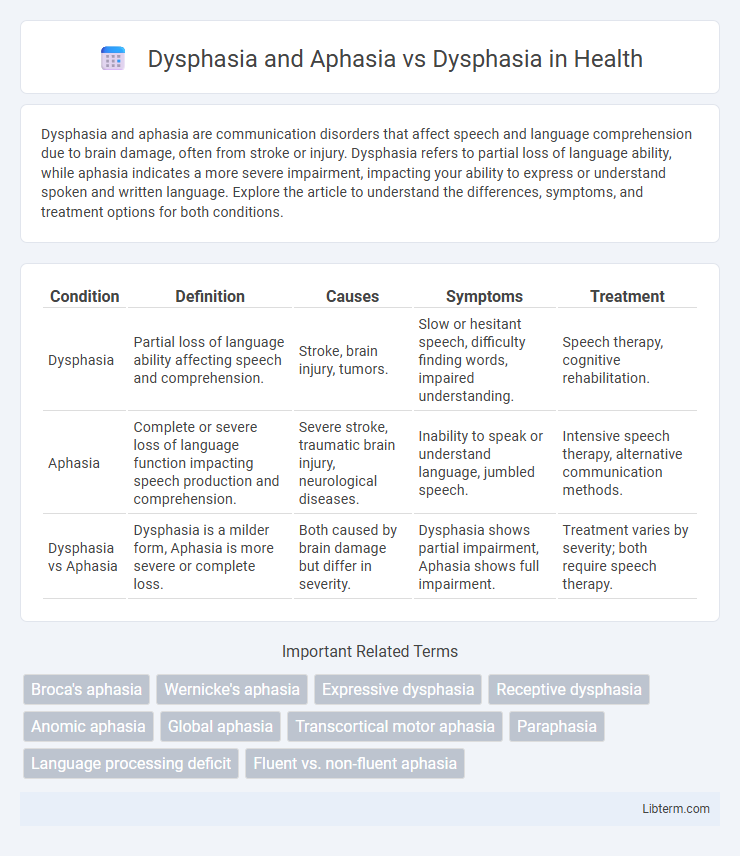Dysphasia and aphasia are communication disorders that affect speech and language comprehension due to brain damage, often from stroke or injury. Dysphasia refers to partial loss of language ability, while aphasia indicates a more severe impairment, impacting your ability to express or understand spoken and written language. Explore the article to understand the differences, symptoms, and treatment options for both conditions.
Table of Comparison
| Condition | Definition | Causes | Symptoms | Treatment |
|---|---|---|---|---|
| Dysphasia | Partial loss of language ability affecting speech and comprehension. | Stroke, brain injury, tumors. | Slow or hesitant speech, difficulty finding words, impaired understanding. | Speech therapy, cognitive rehabilitation. |
| Aphasia | Complete or severe loss of language function impacting speech production and comprehension. | Severe stroke, traumatic brain injury, neurological diseases. | Inability to speak or understand language, jumbled speech. | Intensive speech therapy, alternative communication methods. |
| Dysphasia vs Aphasia | Dysphasia is a milder form, Aphasia is more severe or complete loss. | Both caused by brain damage but differ in severity. | Dysphasia shows partial impairment, Aphasia shows full impairment. | Treatment varies by severity; both require speech therapy. |
Understanding Dysphasia: Definition and Overview
Dysphasia is a language disorder characterized by difficulty in speaking, understanding, reading, or writing due to brain damage, typically resulting from stroke or head injury. Unlike aphasia, which often implies complete or partial loss of language abilities, dysphasia denotes a milder impairment with partial language disruption. Recognizing the specific deficits in dysphasia helps tailor speech therapy to improve communication skills and promote recovery.
Aphasia vs Dysphasia: Key Differences
Aphasia and dysphasia both refer to language disorders caused by brain injury, but aphasia is generally used to describe a complete or severe impairment in language comprehension and expression, while dysphasia denotes a partial or milder difficulty in these areas. Aphasia typically results from stroke, traumatic brain injury, or neurological diseases affecting regions such as Broca's or Wernicke's areas. Dysphasia symptoms may include difficulty in finding the right words, forming sentences, or understanding speech, distinguishing it as a less severe form compared to the often more debilitating effects of aphasia.
Causes of Dysphasia and Aphasia
Dysphasia and aphasia both result from brain damage affecting language processing, often caused by stroke, traumatic brain injury, or infections such as encephalitis. Dysphasia specifically refers to partial loss of language abilities, typically due to localized cortical damage in regions like Broca's or Wernicke's areas. Aphasia represents a more severe impairment, usually following extensive brain damage involving the left hemisphere, impacting speech production, comprehension, reading, and writing functions.
Common Symptoms of Dysphasia
Dysphasia involves impaired language abilities caused by brain injury, characterized mainly by difficulties in speaking, understanding speech, reading, and writing. Common symptoms of dysphasia include trouble finding words, constructing sentences, and processing verbal information, often resulting in fragmented or nonsensical speech patterns. Unlike aphasia, which refers broadly to language impairment, dysphasia specifically denotes partial language dysfunction with some preserved abilities.
Diagnosis: Dysphasia Compared to Aphasia
Dysphasia and aphasia both involve impairments in language processing, but dysphasia is typically considered a milder form affecting speech fluency and comprehension, while aphasia represents a more severe, often global language deficit. Diagnosis of dysphasia involves detailed speech and cognitive assessments to evaluate receptive and expressive language abilities, often employing tools like the Western Aphasia Battery or Boston Diagnostic Aphasia Examination to differentiate it from aphasia. Neuroimaging techniques such as MRI or CT scans support diagnosis by identifying underlying brain lesions, with dysphasia cases showing localized damage primarily in language-related cortical areas.
Types of Dysphasia Explained
Dysphasia encompasses various speech and language disorders characterized by difficulties in understanding or producing language, often categorized into receptive, expressive, and global types. Receptive dysphasia impairs comprehension of spoken or written language, expressive dysphasia affects speech production and word formation, while global dysphasia combines both receptive and expressive difficulties. Unlike aphasia, which broadly refers to language impairment typically caused by brain injury or stroke, dysphasia specifically highlights partial language dysfunction with variations based on the affected brain regions.
Treatment Options for Dysphasia and Aphasia
Treatment options for dysphasia and aphasia primarily involve speech and language therapy tailored to the severity and type of communication impairment. Techniques such as melodic intonation therapy, constraint-induced language therapy, and computer-assisted communication tools have shown significant effectiveness in improving verbal communication skills. Pharmacological interventions may support recovery, but therapy remains the cornerstone for restoring language function in both disorders.
Prognosis: Recovery in Dysphasia vs Aphasia
Recovery in dysphasia is generally more favorable than in aphasia due to the milder and often more localized nature of language impairment, with many patients regaining significant communication abilities through targeted speech therapy. Aphasia, especially global or severe forms, tends to have a slower and less complete recovery trajectory, influenced by the extent and location of brain damage, typically requiring intensive, multidisciplinary rehabilitation approaches. Prognostic outcomes in both conditions correlate strongly with early intervention, lesion size, patient age, and overall neurological health.
Communication Strategies for Patients
Dysphasia and aphasia are language disorders affecting communication, with dysphasia indicating partial language impairment and aphasia representing more severe or complete loss. Effective communication strategies for patients include using simplified language, visual aids, and allowing extra time for responses to enhance understanding. Tailored speech therapy and caregiver training improve patient engagement and facilitate clearer expression despite language challenges.
Preventing and Managing Language Disorders
Effective prevention and management of language disorders such as dysphasia and aphasia involve early diagnosis, speech therapy, and tailored communication strategies. Dysphasia, characterized by partial loss of language abilities, contrasts with aphasia, which often presents as a more severe and complete impairment typically resulting from stroke or brain injury. Consistent intervention through cognitive-linguistic exercises and caregiver support significantly improves recovery outcomes and helps maintain functional communication skills.
Dysphasia and Aphasia Infographic

 libterm.com
libterm.com